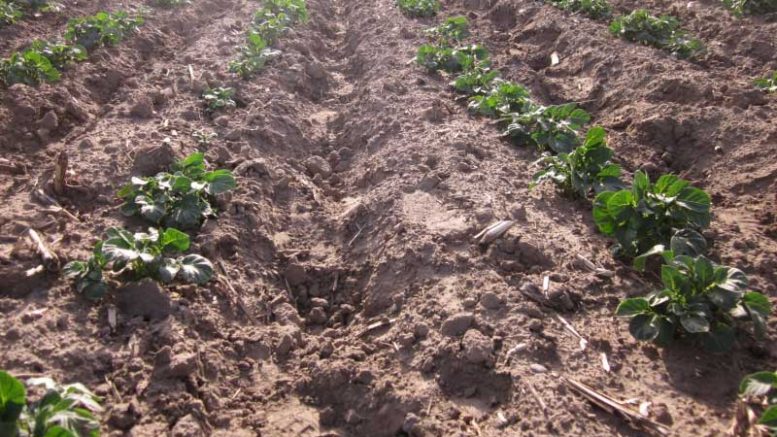|
Click to listen to this article
|
The timing of fertilizer application impacts chloride uptake by the crop
For farmers and researchers, a field is often like a giant chemistry set. The timing and amounts of different fertilizers to supply nutrients can interact with each other, the soil, and crops.
For example, potassium, an essential macronutrient for crops, is often applied to a field in the form of potassium chloride. Potassium and nitrogen are the two nutrients that crops need in abundance. Past research has documented an uptake between chloride and nitrate, a form of nitrogen that crops take up. In crops like potatoes, which are high in potassium, chloride and other salts have been shown to reduce what is called tuber specific gravity.
Specific gravity is a quality evaluation metric used by the potato industry and higher specific gravity increases crop value. A lower tuber specific gravity means a potato will hold more water. While many potatoes are sold to make foods like french fries, more water in the potatoes means more time in the fryer to become crispy. Not only is this more expensive, but the fries may also absorb more fat during frying.
Sarah Light, an agronomy farm advisor with University of California Cooperative Extension, led a study on the timing of potassium chloride in potato fields. Her work was published in Agrosystems, Geosciences & Environment Journal, a publication of the American Society of Agronomy, and Crop Science Society of America.
In the study, the researchers applied three different potassium fertilizers at three different application times during the season. Potassium chloride is the most common and inexpensive potassium fertilizer. They also used sulfate of potash and sulfate of potash magnesia. They applied these fertilizers to different research plot 210 days before planting (fall), 14 days before planting (spring), and 35 days after planting.
They found that the fall application did not increase chloride in the plants. The researchers believe that this is because the chloride was leached below the root depth by the time the potatoes were planted 210 days later. However, the potassium was left in the soil to be taken up and used by the potatoes as they grew.
“Fertilizers are soluble salts and leaching is the process of draining salts from the soil,” Light explains. “Especially in low rainfall areas, high salt content in the crop rootzone, known as soil salinity, is a top reason that fields can become unfarmable.”
Although they did find higher chloride in some of the aboveground parts of the potato plant from spring and in-season applications, it did not greatly impact nitrogen levels. They also found no significant difference in yield or quality — such as specific gravity — between the three fertilizer timings in their specific study.
The study indicated that chloride accumulates more in the stems and leaves of the potato plant, and not in the potatoes themselves.
However, after potatoes are harvested, the stems and leaves are left in the field. The chloride isn’t removed from the field and may increase the risk of elevated chloride in the soil for future seasons. In this study, chloride leached below the rootzone when applied in the fall.
“Potato plants will take up chloride when it is available and chloride will accumulate in plant tissue until potato harvest,” says Light. “Though specific gravity was not affected by treatment in this research, if elevated plant chloride is of concern, applying potassium chloride in the fall is a way to reduce chloride uptake. This is because it has time to travel, or leach, deeper into the soil.”
Light, who conducted this research while a graduate student at Oregon State University, says that she and her team were pleased to find that chloride can travel below the potato root zone, even in a low rainfall area. This provides a way for farmers to minimize risk of lower quality potatoes.
“Optimizing our fertilizer applications is always a high priority in agriculture,” Light says. “It’s important to understand plant, soil, and nutrient dynamics in order to continue to optimize our production systems and improve our efficiencies.”
The research was funded by the United States Department of Agriculture’s National Institute of Food and Agriculture, with support from Compass Minerals. Don Horneck, Oregon State University Extension Agronomist, began this project before passing away in 2014. Dan Sullivan, also with Oregon State University, worked with Sarah Light on this project from 2014 onward.

